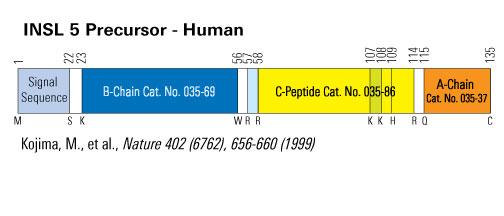|
|
|
C Peptide of INSL5 |
Role in Glucose Homeostasis? |

Insulin-like factor 5 (INSL5), a member of the insulin superfamily, is expressed in the colorectum and hypothalamus. To facilitate studies into the role of INSL5, we generated Insl5(-/-) mice by gene targeting. Insl5(-/-) mice were born in the expected Mendelian ratio, reached normal body weight, but displayed impaired male and female fertility that are due to marked reduction in sperm motility and irregular length of the estrous cycle. Furthermore, Insl5(-/-) mice showed impairment in glucose homeostasis with characteristic elevation of serum glucose levels at an advanced age. Glucose and insulin tolerance tests revealed that the increased blood glucose in Insl5(-/-) mice was due to glucose intolerance resulting from reduced insulin secretion. Morphometric and immunohistological analyses revealed that the Insl5(-/-) mice had markedly reduced average islets area and β-cell numbers. Furthermore, immunohistochemistry showed the expression of INSL5 in enteroendocrine cells in the colorectal epithelium and the presence of its putative receptor relaxin family peptide receptor 4 in pancreatic islet cells. These results suggest the potential role of INSL5 signaling in the regulation of insulin secretion and β-cell homeostasis.
Burnicka-Turek O et al., Endocrinology. 2012 Oct;153(10):4655-65. Epub 2012 Jul 20.
Insulin-like peptide 5 (INSL5) was first identified through searches of the expressed sequence tags (EST) databases. Primary sequence analysis showed it to be a prepropeptide that was predicted to be processed in vivo to yield a two-chain sequence (A and B) that contained the insulin-like disulfide cross-links. The high affinity interaction between INSL5 and the receptor RXFP4 (GPCR142) coupled with their apparent coevolution and partially overlapping tissue expression patterns strongly suggest that INSL5 is an endogenous ligand for RXFP4. Given that the primary function of the INSL5-RXFP4 pair remains unknown, an effective means of producing sufficient quantities of this peptide and its analogues is needed to systematically investigate its structural and biological properties. A combination of solid-phase peptide synthesis methods together with regioselective disulfide bond formation were used to obtain INSL5. Both chains were unusually resistant to standard synthesis protocols and required highly optimized conditions for their acquisition. In particular, the use of a strong tertiary amidine, DBU, as N(alpha)-deprotection base was required for the successful assembly of the B chain; this highlights the need to consider incomplete deprotection rather than acylation as a cause of failed synthesis. Following sequential disulfide bond formation and chain combination, the resulting synthetic INSL5, which was obtained in good overall yield, was shown to possess a similar secondary structure to human relaxin-3 (H3 relaxin). The peptide was able to inhibit cAMP activity in SK-N-MC cells that expressed the human RXFP4 receptor with a similar activity to H3 relaxin. In contrast, it had no activity on the human RXFP3 receptor. Synthetic INSL5 demonstrates equivalent activity to the recombinant-derived peptide, and will be an important tool for the determination of its biological function.
Akhter Hossain M, Bathgate RA, Kong CK, et al. Chembiochem. 2008 Jul 21;9(11):1816-22. doi: 10.1002/cbic.200800113.

Linear Range: 0.33-4.53 ng/ml
Assay Range: 0.1-100 ng/ml
|
|
| Peptide |
Cross-reactivity |
INSL 5 C-Peptide, Prepro(49-106) (Human)
|
100% |
INSL 2 C-Peptide tide (Human) |
0% |
| INSL 3 C-Peptide (Human) |
0% |
| INSL 4 C-Peptide (Human) |
0% |
| INSL 6 C-Peptide (Human) |
0% |
INSL 7 C-Peptide (Human) |
0% |
| Insulin (Human) |
0% |
|

Linear Range: 598.2-4250 pg/ml
Assay Range: 100-12800 pg/ml
|
|
| Peptide |
Cross-reactivity |
INSL 5 C-Peptide, Prepro(49-106) (Human) |
100% |
INSL 2 C-Peptide tide (Human) |
0% |
INSL 3 C-Peptide (Human) |
0% |
| INSL 4 C-Peptide (Human) |
0% |
| INSL 6 C-Peptide (Human) |
0% |
| INSL 7 C-Peptide (Human) |
0% |
Insulin (Human) |
0% |
|

The abbreviations and the sequence sources (GenBank accession no.) are as follows:
RLN3HUMAN: relaxin 3 [Homo sapiens] (NP543140),
RLN3MOUSE: relaxin 3 [Mus musculus] (NP775276),
INSL5HUMAN: Insulin-like 5 [Homo sapiens] (NP005469),
INSL5MOUSE: insulin-like 5 [Mus musculus] (NP035961),
RLN1HUMAN: relaxin 1 [Homo sapiens] (NP008842),
RLN2HUMAN: relaxin 2 [Homo sapiens] (NP604390),
RLN1MOUSE: relaxin 1 [Mus musculus] (NP035402),
INSL4HUMAN: insulin-like 4 [Homo sapiens] (NP002186),
INSL6HUMAN: insulin-like 6 [Homo sapiens] (NP009110),
INSL6MOUSE: insulin-like 6 [Mus musculus] (NP038782),
INSL3HUMAN: insulin-like 3 [Homo sapiens] (NP005534),
INSL3MOUSE: insulin-like 3 [Mus musculus] (NP038592),
IGF1AHUMAN: insulin-like growth factor 1 [Homo sapiens] (NP000609),
IGF1MOUSE: insulin-like growth factor 1 [Mus musculus] (NP001104745),
IGF2HUMAN: insulin-like growth factor 2 [Homo sapiens] (NP000603),
IGF2MOUSE: insulin-like growth factor 2 precursor [Mus musculus] (NP034644),
INSHUMAN: insulin [Homo sapiens] (NP000198),
INS1MOUSE: insulin I [Mus musculus] NP032412),
INS2MOUSE: insulin II [Mus musculus] (NP032413), respectively.
RLNLBRAFL: relaxin-like peptide, predicted protein BRAFLDRAFT100967 [Branchiostoma floridae] (EEA41967),
ILP1BRAFL: insulin-like peptide [Branchiostoma floridae] (see Fig. S1),
ILP2BRAFL: insulin-like peptide 2 [Branchiostoma floridae].
Asterisks indicate positions of amino acids that match completely; : high similarity; . low similarity.
Tips: See More Research Abstracts, Antibody Stainings, Immunoassay Kits Curves and Sequences by clicking the tabs on the top.
|
|
|
INSL5
%035-86%;%035-58%;%035-87%
|
|
|


